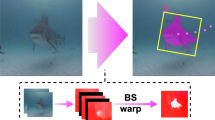Abstract
We propose a deep learning tool to localize fish objects in benthic underwater videos on a frame by frame basis. The deep network predicts fish object spatial coordinates and simultaneously segments the corresponding pixels of each fish object. The network follows a state of the art inception resnet v2 architecture that automatically generates informative features for object localization and mask segmentation tasks. Predicted masks are passed to dense Conditional Random Field (CRF) post-processing for contour and shape refinement. Unlike prior methods that rely on motion information to segment fish objects, our proposed method only requires RGB video frames to predict both box coordinates and object pixel masks. Independence from motion information makes our proposed model more robust to camera movements or jitters, and makes it more applicable to process underwater videos taken from unmanned water vehicles. We test the model in actual benthic underwater video frames taken from ten different sites. The proposed tool can segment fish objects despite wide camera movements, blurred underwater resolutions, and is robust to a wide variety of environments and fish species shapes.
Access this chapter
Tax calculation will be finalised at checkout
Purchases are for personal use only
Similar content being viewed by others
References
Bradski, G., Kaehler, A.: Learning OpenCV: Computer Vision with the OpenCV Library. O’Reilly Media Inc., Sebastopol (2008)
Chen, L.C., Papandreou, G., Kokkinos, I., Murphy, K., Yuille, A.L.: Deeplab: Semantic image segmentation with deep convolutional nets, atrous convolution, and fully connected CRFs. arXiv preprint arXiv:1606.00915 (2016)
Dai, J., He, K., Sun, J.: Instance-aware semantic segmentation via multi-task network cascades. arXiv preprint arXiv:1512.04412 (2015)
Everingham, M., Van Gool, L., Williams, C.K., Winn, J., Zisserman, A.: The Pascal visual object classes (VOC) challenge. Int. J. Comput. Vis. 88(2), 303–338 (2010)
Fier, R., Albu, A.B., Hoeberechts, M.: Automatic fish counting system for noisy deep-sea videos. In: Oceans-St. John’s 2014, pp. 1–6. IEEE (2014)
Girshick, R.: Fast R-CNN. In: Proceedings of the IEEE International Conference on Computer Vision, pp. 1440–1448 (2015)
He, K., Gkioxari, G., Dollár, P., Girshick, R.: Mask R-CNN. In: 2017 IEEE International Conference on Computer Vision (ICCV), pp. 2980–2988. IEEE (2017)
Joly, A., et al.: Lifeclef: multimedia life species identification. In: EMR@ ICMR, pp. 7–13 (2014)
Koltun, V.: Efficient inference in fully connected CRFs with Gaussian edge potentials. Adv. Neural Inf. Process. Syst. 2(3), 4 (2011)
Krizhevsky, A., Sutskever, I., Hinton, G.E.: Imagenet classification with deep convolutional neural networks. In: Advances in Neural Information Processing Systems, pp. 1097–1105 (2012)
Kumar Rai, R., Gour, P., Singh, B.: Underwater image segmentation using clahe enhancement and thresholding. Int. J. Emerg. Technol. Adv. Eng. 2(1), 118–123 (2012)
Labao, A.B., Naval, P.C.: Weakly-labelled semantic segmentation of fish objects in underwater videos using a deep residual network. In: Nguyen, N.T., Tojo, S., Nguyen, L.M., Trawiński, B. (eds.) ACIIDS 2017. LNCS (LNAI), vol. 10192, pp. 255–265. Springer, Cham (2017). https://doi.org/10.1007/978-3-319-54430-4_25
Li, X., Shang, M., Hao, J., Yang, Z.: Accelerating fish detection and recognition by sharing CNNs with objectness learning. In: OCEANS 2016-Shanghai, pp. 1–5. IEEE (2016)
Li, X., Shang, M., Qin, H., Chen, L.: Fast accurate fish detection and recognition of underwater images with fast R-CNN. In: OCEANS 2015-MTS/IEEE Washington, pp. 1–5. IEEE (2015)
Lin, G., Shen, C., van den Hengel, A., Reid, I.: Efficient piecewise training of deep structured models for semantic segmentation. In: Proceedings of the IEEE Conference on Computer Vision and Pattern Recognition, pp. 3194–3203 (2016)
Long, J., Shelhamer, E., Darrell, T.: Fully convolutional networks for semantic segmentation. In: Proceedings of the IEEE Conference on Computer Vision and Pattern Recognition, pp. 3431–3440 (2015)
Negahdaripour, S., Yu, C.H.: On shape and range recovery from image shading for underwater applications. Underwater Robot. Veh.: Des. Control 221–250 (1995)
Ren, S., He, K., Girshick, R., Sun, J.: Faster R-CNN: towards real-time object detection with region proposal networks. In: Advances in Neural Information Processing Systems, pp. 91–99 (2015)
Russakovsky, O., et al.: Imagenet large scale visual recognition challenge. Int. J. Comput. Vis. 115(3), 211–252 (2015)
Sermanet, P., Eigen, D., Zhang, X., Mathieu, M., Fergus, R., LeCun, Y.: Overfeat: Integrated recognition, localization and detection using convolutional networks. arXiv preprint arXiv:1312.6229 (2013)
Spampinato, C., Chen-Burger, Y.H., Nadarajan, G., Fisher, R.B.: Detecting, tracking and counting fish in low quality unconstrained underwater videos. VISAPP 2(2008), 514–519 (2008)
Szegedy, C., Ioffe, S., Vanhoucke, V., Alemi, A.: Inception-v4, inception-resnet and the impact of residual connections on learning. arXiv preprint arXiv:1602.07261 (2016)
Twilley, N., Graber, C.: Gastropod: How many fish are in the sea? counting fish is a daunting but essential task in protecting aquatic ecosystems-and now artificial intelligence, autonomous submarines, and drones can help. https://www.theatlantic.com/science/archive/2016/10/how-many-fish-are-in-the-sea/502937/
Author information
Authors and Affiliations
Corresponding author
Editor information
Editors and Affiliations
Rights and permissions
Copyright information
© 2019 Springer Nature Switzerland AG
About this paper
Cite this paper
Labao, A.B., Naval, P.C. (2019). Simultaneous Localization and Segmentation of Fish Objects Using Multi-task CNN and Dense CRF. In: Nguyen, N., Gaol, F., Hong, TP., Trawiński, B. (eds) Intelligent Information and Database Systems. ACIIDS 2019. Lecture Notes in Computer Science(), vol 11431. Springer, Cham. https://doi.org/10.1007/978-3-030-14799-0_52
Download citation
DOI: https://doi.org/10.1007/978-3-030-14799-0_52
Published:
Publisher Name: Springer, Cham
Print ISBN: 978-3-030-14798-3
Online ISBN: 978-3-030-14799-0
eBook Packages: Computer ScienceComputer Science (R0)




